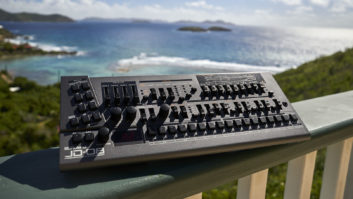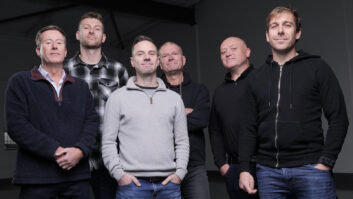At the risk of stating the obvious, 1073 mic preamps and 1176 compressors are very desirable audio devices; they’re classics capable of ideal tones across a broad spectrum of input sources, styles and textures. Neve first marketed the 1073 mic amps—known for their fullness, warmth and euphonic detail—and the units went on to become standards, so much so that they’ve been cloned, copied and replicated by many modern manufacturers (including AMS Neve, still carrying the torch). Elsewhere, Urei first marketed the 1176 compressor, a FET-based design known for its quickness, clean sound and potential aggressiveness—especially when in the over-the-top all-four-ratios-in mode—and that tech, too, is now widely re-created by numerous parties.
With that in mind, it stands to reason that a combination of the two devices in a single piece of hardware could be quite convenient and popular. Producer/engineer/educator Warren Huart recognized that opportunity and paired up with UK Sound, a new division of BAE Audio, to give us the 1173, a unit that is priced much lower than actual vintage units or even some of their modern clones.
Hand-built in California, like all BAE products, the 1173 features a transformer-coupled, fully featured 1073-type mic preamp with up to 70 dB of gain (in 5 dB steps, like the original), 48V phantom power, polarity reversal, a highpass filter (corner frequency unknown) and switchable impedance (150 or 300 ohm—both rather low values, oddly enough). A front-panel instrument DI is offered, as well as a rear-panel line input. The preamp out allows the artistic and oft-employed practice of hitting the preamp hard for some harmonic richness (or even distortion) and then attenuating the level for output—or, more specifically, adjusting level to the compressor’s input.
Related: BAE Audio Offshoot UK Sound to Debut FET Compressors, New Line of 1073 Preamps and Equalizers at NAMM 2018, Jan. 25, 2018
The compressor features all the familiar 1176 controls; ratios of 4/8/12/20 to 1, with the “!” setting equating the “all four in” hyper-aggressive setting that is so popular. The compressor is bypass-able for easy comparisons and also features an HPF in the sidechain, preventing bass-heavy signals from pumping the dynamics. Attack and release controls are offered, even if there is no legend to determine the time values, but the controls are backward, with slow to the left, fast to the right, just like on 1176s. I was delighted to see this attention to detail, as I’m sure most of you likewise detail-oriented engineers are! A master output level control and a VU meter complete the signal path.
Unpacking the 1173, I was pleased to see an all-metal construction, solid build and the appropriate knobs to remind me of its classic inspiration. One rack space isn’t much for all the needed controls, but they all manage to fit comfortably—more comfortably than lots of 500-series gear, to be sure.

Traditionally, 1073s work well with both dynamic and condenser mics, but the DIs sound great, too, and the 1173 is no exception. My passive bass was nicely punchy and warm, and an active bass was a little crisper and hi-fi, just like it ought to be. My Telecaster sounded ok, too; nothing special, but quite useful as a warm front end to an amp sim.
Related: NAMM 2019: UK Sound Previews 1U Rack, 500 Series and Desktop Mic Pre Versions of Classic 1073 Preamplifier, Jan. 25, 2019
I like to mic acoustic guitars in stereo, so I used the 1173 for half my signal on a number of occasions, paired up with a number of large-diaphragm condenser mics (LDCs). Here, the 1173’s flexibility allowed a variety of tones, as I used the impedance sector to dial in the desired high-end texture (you can bring the crispness/detail forward or back a bit), using the HPF to allow overall chestiness or lean-ness, dialing in subtle or grabby compression by balancing preamp out and compression ratios, allowing the low end to stay controlled or bloom with the side chain filter, and finally tweaking that capably fast attack—and the release—for just the right envelope. There’s a lot of combinations here—you can get a usable sound within seconds or tweak for days if you’d rather get your hands dirty. This was all good with fairly loud strumming performances, but lightly fingerpicked ones revealed too much noise floor.
A 1073 feeding an 1176 would probably historically be known as a rock vocal sound, but the 1173 can do more than just that “taming of the beast” kind of tone. Using only LDCs, I found a nice forward-ness and “cut through the mix” ability that wasn’t quite as chesty and low-mid chunky as some 1073s I’ve used. At higher gain levels (+40 dB and up), a noise floor was revealed that wasn’t so much high-frequency hissy as low-mid in nature, so I had to be careful with gain structure. Depending on the nature of the vocal, I could adjust impedance (offering slight tonal balance difference, if not the wide color swings available on some variable impedance mic pres), drive the compressor and filter out proximity effect for some nice flexibility. These variations allowed me to do leads and backups on the same mic by dialing in notable tonal variation instead of switching mics. I had good success with the Roswell Colares and 1173 on rap and pop vocals, for a nice presence and just a touch of grit that wasn’t today’s super-clean rap vocal “sound du jour,” but something a little more colorful and interesting.

I tried the 1173 on a number of drums applications, too—kick, snare, room and hand percussion. Kick was punchy and familiar, if not quite as round and pillowy as some 1073s. Snare was excellent, with that classic 1176 compression doing its thing. Room was my favorite, though, as I could take my AEA ribbon (or sometimes an LDC or the Colares), dial in impedance and either “!” it or play around with excessive compression until something with extreme character was achieved. Hand percussion was captured well, too, with slightly tamed transients and nice, quick FET compression (or sometimes slowed for the converse kind of thing).
Related: Review: Roswell Pro Audio Colares Condenser Mic, by Rob Tavaglione, Jan. 31, 2019
Overall, the controls and switches were smooth and firm, especially the input gain selector, with its classic styling. I did find myself wishing for some input or output metering, as the small VU shows compression attenuation only. I noticed that the noise floor changed in both volume and frequency when the preamp out and main output are adjusted, with sudden changes at certain points in the pot’s travel. Both controls are in a “good-sounding zone” right around unity gain, which was close to where I used them in typical operation, but if you need to crank them for some creative gain staging, you may encounter noise problems.
Summary
When I think of the spectrum of 1073s and 1176s I’ve heard in numerous form factors and at various price points, the 1173 comes across as a 1073 with a slightly sweeter/brighter top end, a slightly leaner/tighter low end and a little less low-mid plumpness, even at higher overdriven gain settings. The 1173’s compressor comes across as your typical wildly versatile 1176, with all the right quirks and maybe a little more airiness and less saturation. It’s hard to find exact details on the 1173’s components, so I’m going to venture to say the tonal difference and distinctiveness of the 1173’s tone is mostly due to the input and output transformers (a detail that 1073 lovers debate endlessly). The transformers found here are from UK manufacturer OEP, a division of Carnhill, the maker of the original 1073’s transfos. These OEPs sound good, if not quite as chunky (or expensive) as Carnhills or even the Vigortronix found in AMS Neve’s modern designs.
Want more stories like this? Subscribe to our newsletter and get it delivered right to your inbox.
For that truly authentic 1073 tone, perhaps a BAE Audio clone or comparable top-shelf unit could provide that vintage sound. However, for a more modern variation, the 1173 will do just fine, as would a number of other 1073 and 1176 re-creations on the market for about $600 each. At $1,200, the 1173 offers a comparable price and functionality, but all in only one rack space—not the three rack spaces required for two separate units. Time will tell if these 1073s hold up in durability and competitiveness, but for now, they should definitely be considered as a way to get both 1073 and 1176 hardware tone without breaking the bank.
UK Sound • www.uksound.com







